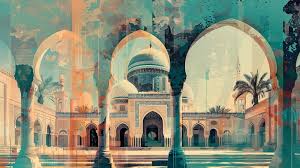Mosques have stood for centuries as beacons of faith, culture, and artistic expression. These sacred spaces, deeply rooted in Islamic tradition, are not just places of worship but also testaments to the creativity and craftsmanship of their architects. From the intricate patterns adorning their walls to the soaring minarets that call the faithful to prayer, mosques encapsulate a blend of spirituality and architectural brilliance.
Historical Significance of Mosque Architecture
The history of mosque architecture is as old as Islam itself. The first mosque, Masjid al-Quba, was established by the Prophet Muhammad in Medina, serving as a simple yet profound space for communal prayer. Its design was modest, with palm trunks for pillars and a thatched roof, symbolizing humility and unity.
As Islam spread across different regions, the architecture of mosques began to reflect the local cultures and artistic traditions. From the grand mosques of the Ottoman Empire to the intricate designs of Mughal architecture in India, each mosque became a unique amalgamation of regional styles and Islamic principles. Despite these differences, certain elements, such as the mihrab (a niche indicating the direction of Mecca) and the minaret, became defining features of mosques worldwide.
Key Elements of Mosque Architecture
1. The Dome
One of the most iconic features of a mosque is its dome, which often symbolizes the vault of heaven. Domes are not just architectural marvels; they also enhance the acoustics within the prayer hall, allowing the imam’s voice to carry clearly during sermons.
Famous examples include the massive dome of the Hagia Sophia in Istanbul, later converted into a mosque, and the blue-tiled dome of the Shah Mosque in Isfahan, Iran. These domes often feature intricate calligraphy, geometric patterns, and vibrant colors, turning them into celestial canvases.
2. The Minaret
Minarets are tall, slender towers that have become synonymous with mosques. Originally, they served as platforms for the muezzin to call the faithful to prayer. Today, they remain an essential part of mosque architecture, symbolizing the connection between earth and sky.
The spiral minaret of the Great Mosque of Samarra in Iraq and the elegant minarets of the Sultan Ahmed Mosque (Blue Mosque) in Turkey are celebrated for their architectural innovation and beauty.
3. The Mihrab and Qibla Wall
The mihrab, located in the qibla wall, is a semi-circular niche that directs worshippers toward Mecca. Often adorned with exquisite mosaics or carved inscriptions, the mihrab serves as both a spiritual guide and an artistic centerpiece.
In mosques like the Alhambra in Spain, the mihrab’s intricate arabesque designs and golden hues create an aura of reverence and splendor.
Regional Variations in Mosque Architecture
Middle Eastern Mosques
Middle Eastern mosques often feature large courtyards, hypostyle halls, and a focus on simplicity and symmetry. The Great Mosque of Kairouan in Tunisia, one of the oldest mosques in the world, showcases this traditional style with its vast prayer hall and sturdy, square minaret.
Ottoman Mosques
The Ottoman Empire brought a unique style to mosque architecture, blending Byzantine influences with Islamic principles. The Süleymaniye Mosque in Istanbul, designed by the renowned architect Mimar Sinan, is a prime example. Its grand dome, harmonious proportions, and intricate tile work highlight the sophistication of Ottoman design.
Mughal Mosques
In South Asia, the Mughal Empire left an indelible mark on mosque architecture. The Jama Masjid in Delhi and the Badshahi Mosque in Lahore are masterpieces of Mughal design, featuring red sandstone, white marble, and detailed inlays that exude grandeur.
Southeast Asian Mosques
Mosques in Southeast Asia, such as the Istiqlal Mosque in Jakarta, often incorporate local architectural elements. These mosques may feature tiered roofs instead of domes, reflecting the region’s traditional building styles while maintaining Islamic aesthetics.
The Symbolism of Mosque Architecture
Every aspect of mosque design carries profound symbolism. The geometric patterns and arabesques often seen in mosque interiors represent the infinite nature of creation, while calligraphy serves as a visual celebration of the Quran’s teachings. The harmonious proportions of mosques reflect the Islamic emphasis on balance and unity, both in worship and in life.
Mosque Architecture in the Modern Era
In the modern era, mosque architecture continues to evolve, blending tradition with innovation. Contemporary mosques like the Sheikh Zayed Grand Mosque in Abu Dhabi showcase a fusion of classical and modern styles, incorporating cutting-edge technology to enhance both aesthetics and functionality.
Meanwhile, eco-friendly mosques, such as the Cambridge Central Mosque in the UK, prioritize sustainability by utilizing renewable energy, natural lighting, and green spaces. These designs demonstrate how mosque architecture adapts to modern needs while preserving its timeless essence.
The Universal Appeal of Mosques
The beauty of mosque architecture transcends religious boundaries. Visitors from all walks of life marvel at the artistry, craftsmanship, and spiritual ambiance of mosques. These structures are not only places of worship but also cultural landmarks that inspire awe and foster understanding.
For instance, the Alhambra in Spain and the Dome of the Rock in Jerusalem are celebrated globally for their architectural and historical significance. They serve as reminders of the rich cultural heritage that mosques embody.
A Legacy of Timeless Elegance
Mosques are much more than buildings; they are enduring symbols of faith, art, and community. From their historical roots to their modern iterations, mosques continue to captivate the world with their timeless elegance and profound significance.
As we look to the future, the evolution of mosque architecture will undoubtedly continue to reflect the beauty of Islamic culture while addressing the needs of a changing world. Whether through traditional craftsmanship or modern innovation, mosques will remain a testament to the harmonious blend of spirituality and artistry.
